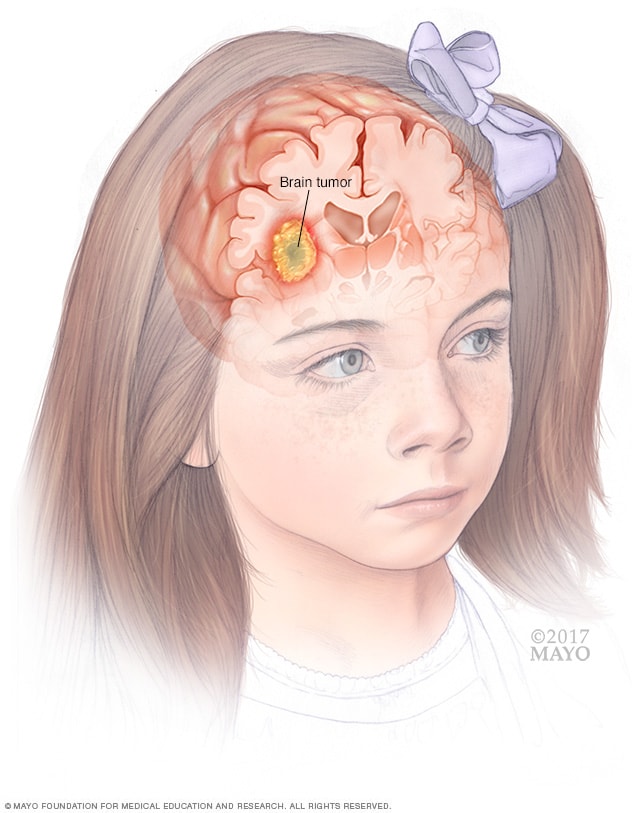Overview
Pediatric brain tumor

Pediatric brain tumor
This shows a child's tumor that likely began in the brain cells. As the tumor grows, it can create pressure on the surrounding brain tissue. This causes brain tumor symptoms, such as headaches, nausea and balance problems.
Pediatric brain tumors are growths of cells that start in or near the brain in children. The growths, called tumors, can grow to press on nearby parts of the brain. This can cause symptoms, such as headaches and nausea.
Many types of pediatric brain tumors exist. Some grow quickly, and some grow slowly. Some are cancerous, and some aren't cancerous. Noncancerous brain tumors also are called benign brain tumors.
The type of brain tumor a child has helps determine the best treatment plan. Other things your child's healthcare team considers include the tumor's location, whether it has spread beyond the brain, and your child's age and overall health.
Treatment for brain tumors in children is often quite different from treatment for adult brain tumors. For this reason, seek out care at a medical center that has experience caring for children with brain tumors.
Products & Services
Types
Symptoms
Pediatric brain tumor symptoms may vary depending on the tumor's location within the brain. Symptoms also might depend on the size of the tumor and how quickly it's growing.
Some of the more common signs and symptoms of pediatric brain tumors include:
- Headaches, which may become more frequent and more severe. In children who don't talk, a parent might notice that the child is more irritable than usual.
- Nausea and vomiting.
- Vision changes, such as double vision. In children who don't talk, a parent might notice that a child squints or covers one eye when trying to look at something.
Other possible signs and symptoms include:
- A fuller soft spot on the skull in babies.
- Changes in the way the eyes move.
- Confusion and irritability.
- Difficulty with balance.
- Hearing problems.
- Memory problems.
- Personality or behavior changes.
- Seizures, especially in a child who hasn't had a seizure before.
- Slurred speech.
- Trouble walking.
- Trouble swallowing.
- Weakness or drooping on one side on the face.
- Weakness or loss of sensation in an arm or a leg.
When to see a doctor
Make an appointment with your child's doctor or other healthcare professional if your child has symptoms that worry you.
Causes
Most of the time, the cause of a pediatric brain tumor isn't known.
Pediatric brain tumors start when cells in the brain develop changes in their DNA. A cell's DNA holds the instructions that tell a cell what to do. In healthy cells, the DNA gives instructions to grow and multiply at a set rate. The instructions tell the cells to die at a set time. In tumor cells, the DNA changes give different instructions. The changes tell the tumor cells to make many more cells quickly. Tumor cells can keep living when healthy cells would die. This causes too many cells.
The extra cells might form a mass called a tumor. A tumor can grow and press on nearby brain tissue. Sometimes a growing tumor causes swelling and other changes in the nearby brain tissue.
Some tumor cells develop other DNA changes that turn them into cancer cells. Cancer cells can invade and destroy healthy tissue. Sometimes cancer cells can break away and spread beyond the brain. If brain cancer spreads, it tends to go to the fluid that surrounds the brain and spinal cord. This fluid is called cerebrospinal fluid.
Risk factors
Factors that may increase the risk of pediatric brain tumors include:
Younger age
Brain tumors can happen at any age. In children, brain tumors tend to happen more often in those younger than 5.
Exposure to radiation
Children who receive radiation therapy treatments to the head have an increased risk of brain tumors. For example, radiation therapy for one type of brain tumor may increase the risk of developing another type of brain tumor.
Weakened immune system
If the body's germ-fighting immune system is weakened by medicines or illness, there might be a higher risk of pediatric brain tumors. Children with weakened immune systems include those taking medicines to control their immune systems, such as after organ transplant. Certain medical conditions, such as infection with HIV, can weaken the immune system.
Genetic syndromes that run in families
Some genetic syndromes that run in families can increase the risk of brain tumors in children. Examples include:
- Neurofibromatosis 1.
- Neurofibromatosis 2.
- Tuberous sclerosis.
- Gorlin syndrome.
- Turcot syndrome.
- Cowden syndrome.
Tests of your child's DNA can show whether these syndromes are present.
Prevention
There's no way to prevent pediatric brain tumors. If your child develops a brain tumor, you didn't do anything to cause it.
Dec. 05, 2024